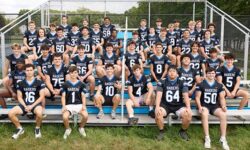By Madison Butkus
Hometown Weekly Reporter
It was all about waves, sound, and light when the Children’s Museum Easton made a special visit to the Sherborn Library. Attendees gathered in the community room to explore vibrations, absorption, and variables through various science experiments.
The event was led by Krissy Cannizzo, the director of education and outreach for the Children’s Museum Easton. She guided participants in creating two classic childhood toys: a kaleidoscope and a harmonica.
At the beginning of the event, Cannizzo handed out paper bags containing all the materials needed to make the toys. The first project was a kaleidoscope, made using reflective paper, a cardboard cylinder, a lollipop stick, tape, paper discs, and markers.
Before diving into the craft, Cannizzo demonstrated how kaleidoscopes work by showing two examples she brought with her. She explained that, while kaleidoscopes typically use mirrors to create patterns, they would be using reflective paper to avoid the use of glass.
With this knowledge, the children and their guardians taped three pieces of reflective paper into a triangle shape and placed it inside the cardboard cylinder. They then decorated one of the paper discs, which had a small hole in the center.
Cannizzo explained that there was no need for intricate designs, as the science would create the patterns when they looked into the kaleidoscope. She also provided extra discs for decorating at home.
After completing the decoration, it was time to attach the lollipop stick to the cylinder and insert the decorated disc, leaving some space for light to enter. When the children pointed their kaleidoscopes toward the light and spun the discs, they saw the patterns inside.
Next, Cannizzo showed attendees how to make their own harmonicas using two craft sticks, two skinny rubber bands, one thick rubber band, and two straw pieces.
The first and most crucial step was stretching the thick rubber band from the bottom to the top of one craft stick. Cannizzo explained that this would create the vibrations that produce sound. Attendees then placed the straw pieces under the rubber band at the top and bottom and secured the second craft stick on top with the skinny rubber bands.
When blowing into their harmonicas, Cannizzo explained that no noise was needed from the children—the air and the thick rubber band would create the sound. If it didn’t work right away, she suggested adjusting the straws and rubber bands.
Due to the potential volume of the handmade harmonicas, Cannizzo advised the children not to play them near pets or people’s faces, in the car, or on the bus, and to play safely overall.
The best part was that not only were the children having fun, but they were also learning about the fascinating aspects of science. At the end of the program, attendees took their creations home.
For more information about upcoming events at the Sherborn Library, visit www.sherbornlibrary.org.






















